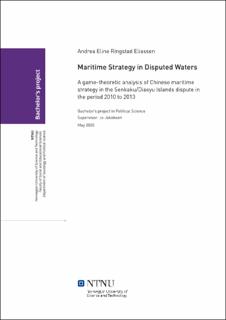Maritime Strategy in Disputed Waters
Bachelor thesis
Permanent lenke
https://hdl.handle.net/11250/2661124Utgivelsesdato
2020Metadata
Vis full innførselSamlinger
Sammendrag
The purpose of this thesis is to identify China’s maritime strategy in the Senkaku/Diaoyu Islands dispute from 2010 to 2013, while challenging the notion that this dispute is best understood as a Chicken game in game theory. The research includes a review of the Senkaku/Diaoyu Islands dispute with a focus on the fishing trawler incident of 2010, and the island purchase of 2012; an explanation of sub-threshold strategies such as salami tactics and the use of intermediaries; and the context of sub-threshold strategies in China’s reaction to the incidents of 2010 and 2012, and the significance of the Chinese board game Go in Chinese strategy. Through a game-theoretic analysis using Prisoners’ Dilemma, Bluff, and Easy Win games, the findings suggest that China’s maritime strategy is characterized by exploiting their economic and military power compared to Japan, as well as the structure of the dispute, by applying sub-threshold strategies to gain territory without fighting while maintaining their “face” in the East Asian region. Chinese strategies appear influenced by the mindset of the Chinese board game Go, as well as Sun Tzu’s Art of War. Regarding the notion that the dispute is best understood as a Chicken game, the findings suggest that due to the difference in power between China and Japan, among other things, that the dispute is better understood as a Prisoners’ Dilemma game or a game where the players have asymmetrical preferences, such as a Bluff or Easy Win game.
